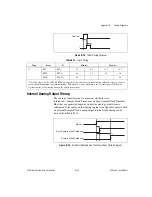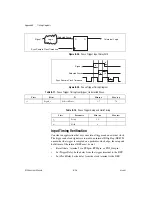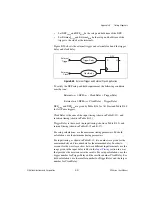
Appendix B
Timing Diagrams
B-32
ni.com
Table B-22.
DI Timing Delays
Time
From
To
Min (ns)
Max (ns)
t
3
*
PFI
PFI_i
5.2
6.2
18.2
22.0
RTSI
RTSI_i
2.0
2.5
5.0
6.0
PXI_STAR
PXI_STAR_i
1.5
3.5
t
4
PFI_i, RTSI_i, PXI_STAR_i, or
other internal signal
DI Sample Clock
3.5
9
t
7
P0
P0_i
4.7
20.1
t
8
DI Sample Clock
PFI (output)
8.0
29.8
t
9
†
PFI (output) high
PFI (output) low
One period of
80 MHz Timebase
Two periods of
80 MHz Timebase
*
The delay ranges given for PFI and RTSI represent the fastest and slowest terminal routing within the trigger group for a
given condition (maximum or minimum timing). This difference can be useful when two external signals will be used
together and the relative timing between the signals is important.
†
When DI Sample Clock is routed to a PFI output pin, the pulse width of the output is independent of the pulse width of the
input. The pulse width is specified in a number of periods of the 80 MHz Timebase
Table B-23.
DI Timing Requirements
Time
Requirement
Condition
Min (ns)
Max (ns)
t
1
PFI, RTSI, or PXI_STAR
Minimum Period
When used as DI Sample
Clock
NI 622
x
devices: 1000.0
NI 625
x
/628
x
devices: 100.0
—
t
2
PFI, RTSI, or PXI_STAR
Minimum Pulse Width
When used as DI Sample
Clock
12.0
—
t
5
Setup time From P0_i to
DI Sample Clock
—
1.5
—
t
6
Hold time From DI Sample
Clock to P0_i
—
0
—















































